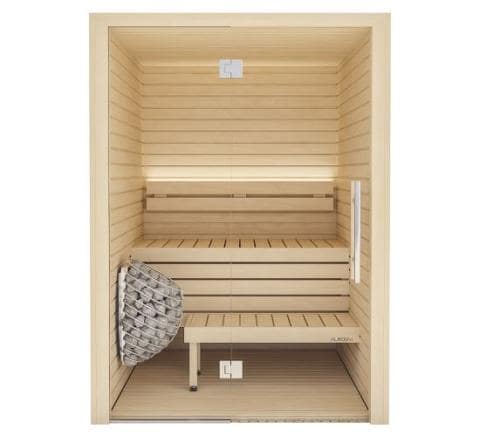Getting The Traditional Sauna To Work
Wiki Article
How Traditional Sauna can Save You Time, Stress, and Money.
Table of ContentsThe Ultimate Guide To Traditional SaunaThe Greatest Guide To Traditional SaunaExamine This Report on Traditional SaunaGetting The Traditional Sauna To Work
A lot of the weight shed in a sauna is water loss and is re-gained upon rehydrating. Without a question sauna can be a crucial part of a healthy weight loss program. To take a look at the differences between conventional and IR saunas, I will certainly separate these right into verifiable, academic, and fabricated distinctions.Therefore, the hottest factor in the saunawhich goes to the ceiling straight over the sauna heateris typically between 185 and 190 F. Traditional Sauna. Claims that a standard sauna goes beyond 200 F is merely not real and not relevant for electrical saunas marketed in the United States. The temperature level for a far-infrared sauna is generally set between 120 and 140 F; however, unlike the conventional sauna, the goal in and IR area is not to accomplish a heat
Because of this, the temperature level distinction is almost unimportant, since extreme sweating leads to both sauna kinds, yet the technique of heating the body is various. In an IR sauna the bather will certainly really feel warm and will sweat profusely, but at a lot lower temperature levels. Thus, if the goal is to spend longer periods of time in the sauna, the IR sauna is a good choice.

The smart Trick of Traditional Sauna That Nobody is Talking About
When the high temperature is attained, the aspects cycle on and off to maintain the high temperature. Many typical sauna customers enjoy pouring water over the rocks to create steam to raise sauna humidity levels. The benefits of pouring water over the rocks consist of: making the room much more comfy, dampening the nasal passages, and allowing the usage of aromatherapy by blending essential oils with the water.In a far-infrared sauna, the warm front pass through the body to effectively heat the body and raise the body core temperature level. To attain this raised temperature, Far-infrared emitters create infrared power which is close to the very same wavelength as that which the body normally emitsoften described as the "Vital Range" of 7 to 14 microns), so the energy is well received by the body.
When the pop over to these guys energy gets in the body, it creates the body temperature level to raise and inevitably causes sweat. In an infrared sauna it is essential for the emitters/heaters to continue to be on almost frequently. Considering that there is no mass of rocks to retain warmth, the sauna will cool if the emitters shut off.
As pointed out above, the sauna bather in an infrared area wishes to position himself before operating emitters to get optimal gain from the warmth. The home heating time for the two areas can be really different, depending upon how the rooms are made use of. For a traditional sauna, a bather should permit 30-40 mins for the room to achieve a desired temperature and to effectively pre-heat the rocks.
Traditional Sauna Things To Know Before You Get This
A well built sauna will normally attain a temperature of 150-160 F in regarding 30-40 minutes. For hotter temperature levels, the area might need to warm for a longer duration.To some, 15 mins was "wasted" while the infrared energy heated up the timber panels instead of heating up a body, while others discover a pre-heated area to be more comfy and believe an elevated beginning temperature level is necessary to begin perspiring. The size of advised usage for each room is roughly the exact same (10-15 minutes per session); nevertheless, because of the lower air temperatures and the ability to feel the impacts of infrared heat quicker than a traditional sauna, it is not uncommon for a person to invest a total amount of 20-30 mins in an infrared sauna.
Traditional saunas have a tendency to be larger (hence use even more power) than infrared saunas, although typical saunas are absolutely readily available in one and 2 person sizes. For a two-person typical sauna, 5x6 or 5x7 look at here dimension is most popular. The leading bench can pleasantly seat 2 or three people and is also long sufficient to rest throughout the sauna session.


The typical cost per kWH of power in the U.S. is approximately $0.11, so a 4.5 kW heating system will set you back roughly $.50 to compete one hour, if the heater runs constantly for one hour. Generally a sauna heating system will run for 75% of the initial hour and 50% of subsequent hours on considering that the components cycle once the set temperature level is achieved.
Everything about Traditional Sauna
A 2 person far-infrared area is usually literally smaller sized than a traditional sauna, usually about 4' x 4' or smaller sized. The IR heating system is generally 1.5-1.7 kW using a 120 volt 15 amp plug-in solution. Since the area can be made use of earlier than a sauna room, we will certainly assume the area is used for to of an hour including warm up time.There is a rarely gone over distinction in the social experience between the two spaces. While our culture has actually shed a few of the social advantage of the conventional sauna experience, it can be very socially satisfying. From household time in the sauna, to heart-felt discussions with loved ones, to sauna you can find out more partiesthe standard sauna experience can lead to intimate mingling.
The majority of higher end infrared areas include tinted light therapy, noise systems and full-glass fronts.
Report this wiki page